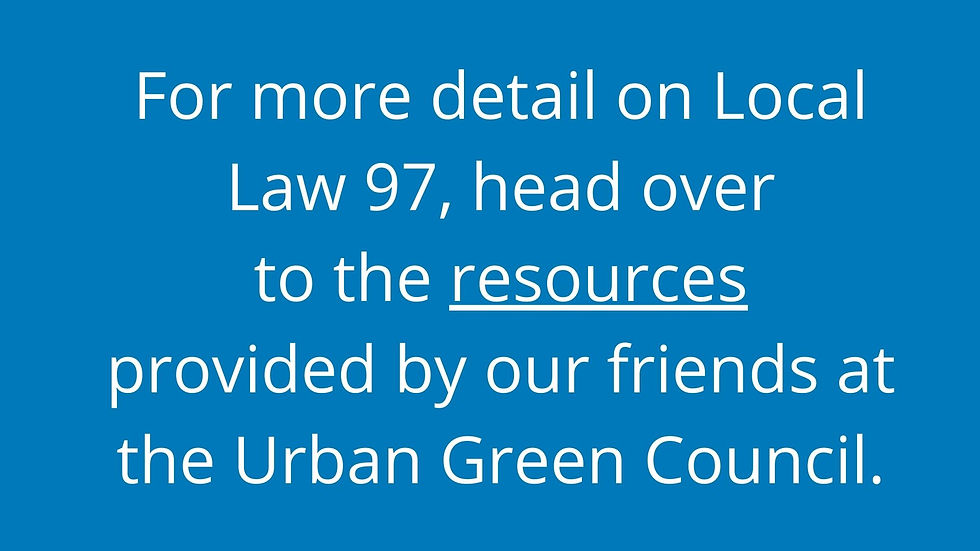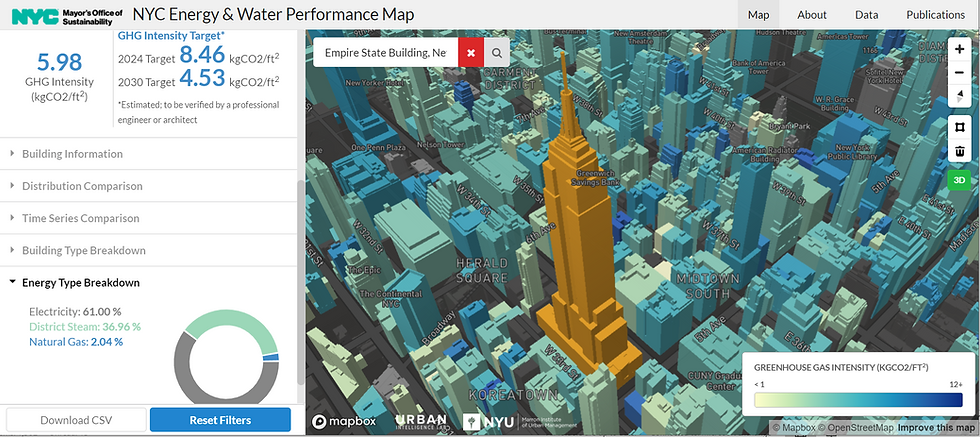- Oct 6, 2020
- 9 min read
What you Need to Know About Complying with NYC's Local Law 97 (Part 1)
So, you’ve heard about NYC’s Infamous LL97, but you're not sure how to comply? In this 2-part blog, I will provide some insight into the bigger picture, how to understand just how much work your building needs to meet compliance, and provide a few updates. In part 2 I’ll break down how to start taking action in digestible steps. In both, I’ll touch on a couple other laws that are worth noting.
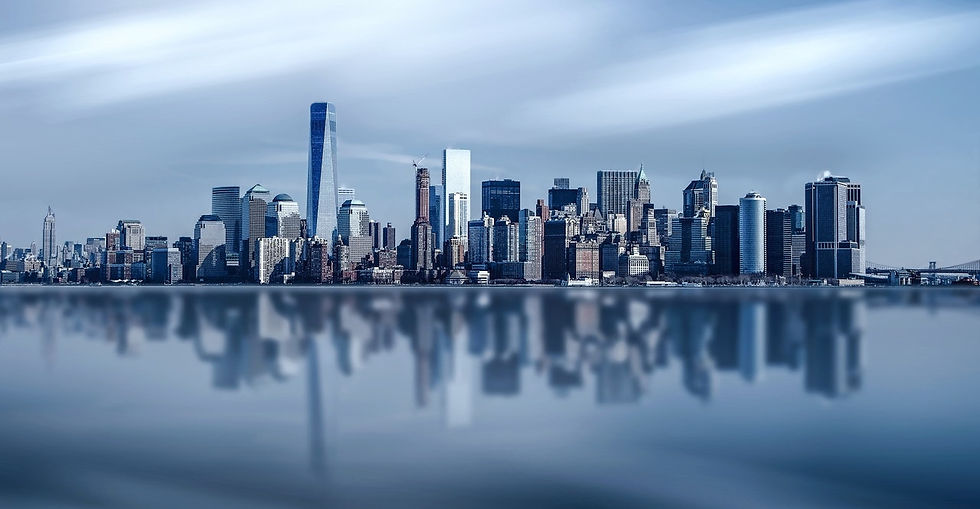
If you have been following New York City climate action at all, you’ve likely heard the phrase ‘Local Law 97.’ It is a hot topic in the real estate industry and often triggers some sort of emotion. Well, that’s because it’s kind of a big deal! While mayors across the country have voluntarily committed to upholding the Paris agreement in their cities, New York City is one of the only cities with action and substantial penalties tied to carbon reduction goals.
While it is a big deal, determining how to comply with Local Law 97 and other notable climate laws doesn’t have to be a pain.
The basic premise behind LL97 is that all buildings over 25,000 square feet (with some exception) are required to meet carbon emissions caps, in kg CO2e/square feet of building, for your building type starting in the calendar year 2024. That means annual net emissions for 2024 and subsequent years must be at or below the limit. If your building’s emissions are over the limit, there is a fine of $268 per metric ton CO2e over.
With just this basic understanding of the law, the following sections provide some actionable steps and insight into your unique building’s needs.
Understand how your building is currently performing relative to Local Law 97:
1. Are you responsible for taking action and paying the potential LL97 fines? Do you own your building? If you do not, then as of now you are off the hook. However, you can be a model tenant, help your landlord and save yourself money if you act towards reducing your energy use, and thereby greenhouse gas emissions, anyway.
2. Is your building required to meet the law? Most buildings over 25,000 sf within the 5 boroughs are required to do so. Check the detailed requirements of covered buildings here. A good rule of thumb is that if your building must comply with LL84, the benchmarking law, it must comply with LL97.
3. What is your building’s current carbon emissions? NYC has a handy database that will tell you the greenhouse gas emissions for all covered buildings, compared to the upcoming limits, based on data submitted through the benchmarking requirement. Even better, if you have available a year’s worth of electricity bills and your building occupancy type, you can plug it into the Building Energy Exchange’s LL97 Carbon Calculator, which will estimate current emissions and predict energy costs, inclusive of fines for 2024 - 2034.
4. What might your LL97 fines be? The fine is $268/metric ton of CO2e (carbon dioxide equivalent) over the limit and can be estimated using the Building Energy Exchange calculator mentioned in the last step or through some simple arithmetic.
5. What is driving your current carbon emissions? There are two main contributors to carbon emissions in building operations: 1) combustion heating (fossil fuel-based, on-site) and 2) electricity.
-
Heating: Emissions from water and space heating depend on the source of fuel used (fuel oil # 4 is the dirtiest with district steam being the least dirty). Electric heating is the least carbon-intensive due to the gains in efficiency from electric heating technology.
-
Electricity: This is pretty much everything else that isn’t on-site heat. The carbon emissions associated with electricity is dependent on the New York City grid mix. Building owners and occupants cannot change the emissions intensity but they can reduce the amount of electricity used.
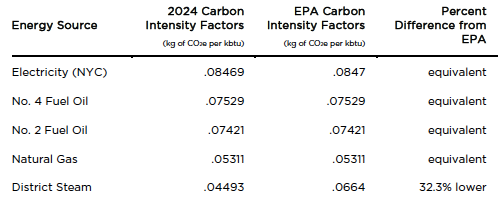
Of course, a big key is quantity. Reduction is always the best first solution and often the one with most clear savings. Beyond this, it is important to get to the bottom of how energy is being used in your building. If your building has already gone through the energy audit required by LL87, the results and commissioning report are a great place to start. If not, an energy audit and energy management software (installed to break down energy use types in as much detail as possible) can provide helpful clues as to how energy is being used.
3 things to watch over the next couple of years:
1. The carbon trading program. The law requires that a carbon trading program is proposed by the Advisory Board in early 2021. It will be available for New York City buildings that must comply with the law and could be a revenue generation opportunity for those buildings that are lower than their limit for the year. Mechanisms are TBD and the Urban Green Council has done a great job of laying out what it could and should look like.
3. Development of the tenant-landlord relationship in their role to comply with the law. Only owners are responsible for the penalty, if not in compliance, but tenant use typically accounts for 40-60% of total building energy demand. Many landlords are trying to figure out how they will tackle the tenant portion since tenants are not motivated by the penalty to reduce their energy consumption. Models to address this will emerge over the next few years.
Other notable laws: LL88 & LL95
New York City Council has been hard at work over the last 11 years creating the Greener Greater Buildings Plan (2009) and the Climate Mobilization Act (2019), the latter of which is where LL97 comes from. Each law serves a unique purpose. Two additional laws to note:
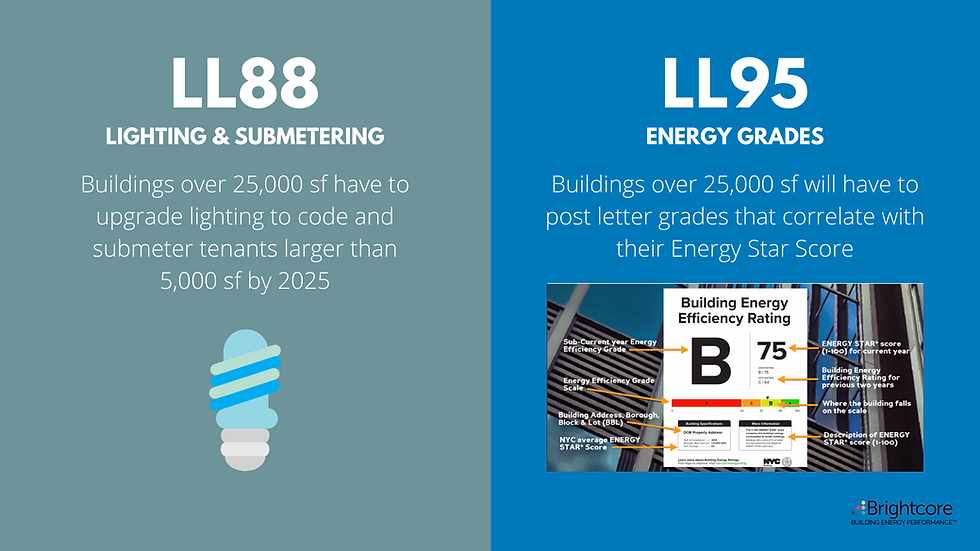
As a company that cares a lot about sustainability and is fortunate enough to be located in a region that is taking the future of our planet seriously, Brightcore is looking forward to continuing the conversation on regional climate laws and other drivers that are resulting in meaningful change.
Eileen Quigley is Director, Client Sustainability at Brightcore. She contributes to our sustainability blog, where we share insights on clean energy solutions for your business or institution, whether you have a fully formed corporate social responsibility plan or you are just starting to consider a renewable energy or energy efficiency strategy. Follow Eileen (@EcoQuig) and Brightcore (@BCEnergy) on Twitter.



